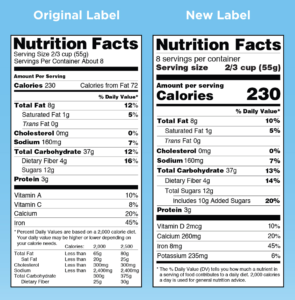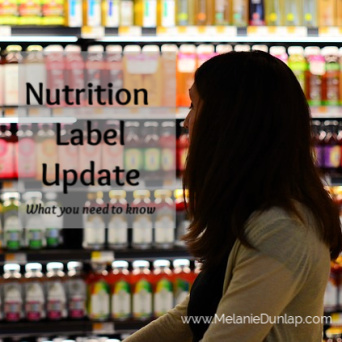Anyone that cares about good nutrition and staying healthy should be familiar with nutrition labels. In 1990 the Nutrition Labeling and Education Act (NLEA) was passed. It requires all packaged foods to have nutrition labeling and use consistent terms. By 1994 the food ingredient panel, serving sizes and terms were standardized, and the nutrition label was born.
In 2016 the food label got an overhaul. You may not have noticed yet because the switch is still going on, large manufacturers have until January 2020 to implement the change and smaller manufacturers have until January 2021.

Here is what to look for in your new labels.
As someone that is always reaching for a pair of reading glasses, I am personally grateful for the larger font size! The “calories”, “serving size” and “servings per container” are all larger. The number of calories and serving size are now also in bold type.
Serving Size Changes
The last time serving size standards were published was 1993. Serving sizes are meant to reflect the amount a person really eats or drinks in one sitting, not necessarily what they should eat in one sitting.
Since 1993 the average serving size has increased. The new labels have made the following changes in serving size:
- A serving size for ice cream will be 2/3 cup instead of the previous 1/2 cup
- A soft drink serving size has increased from 8 ounces to 12 ounces
- A serving of yogurt has decreased from 8 ounces to 6 ounces
I couldn’t help but notice that the healthiest item on the list is the only one that reduced in serving size!
Did you ever look at the nutrition label on a single serve item and think you were doing something healthy only to realize it was misleading? Under the old labeling system, a 12-ounce package and 20-ounce package would have the same calorie number in bigger type only to have the serving size and number of servings in much smaller type. In order to calculate how many calories were in that single serve item you had to multiply the calories by the total number of servings.
The new guidelines consider packaging that would typically be consumed all at one time to be a single serving and will show the total amount of calories. No math required.
New to the Label
Added sugars: New labels list both total sugar and added sugars. The 2015-2020 Dietary Guidelines for Americans shows a common source of excess calories in the typical Western diet to be added sugars. Additional sugar is often added to sweetened beverages and snacks. Look for the added sugars as a separate line on the new label.
Required vitamins and minerals: Past labels listed the amount of calcium, iron and vitamins A and C. On the new label calcium and iron are still required but vitamins A and C are no longer required because deficiencies in these vitamins are rare in our diet. Instead, vitamin D and potassium must now be listed, along with calcium and iron, because they have been identified as lacking in the typical American diet.
Calories from fat: This will no longer be shown on the new labels. Research has shown that the type of fat, saturated vs polyunsaturated fat, is more important than the total amount of fat when weighing a food’s impact on health and disease prevention. The new labels will continue to break down the amount of “total fat”, “saturated fat” and “trans fat.”
The Daily Values
While the daily values are still based on a 2,000 calorie per day diet, the recommendations for the daily value of some nutrients have changed.
| Nutrient | Old Daily Value | New Daily Value |
| Sodium | 2,300 milligrams (mg) | 2,400 mg |
| Fiber | 25 grams (g) | 28 g |
| Vitamin D | 400 international units (IU) | 800 IU |
| Calcium | 1,000 mg | 1,300 mg |
| Potassium | 4,700 mg | 3,500 mg |
What This Means to You
Updates to nutrition labels were definitely needed but they don’t tell the whole story. Each one of us is unique and finding the right balance of nutrition for your body is an important component to good health. Understanding nutrition labels is key to creating healthy eating habits.
If eating right seems overwhelming or you don’t know how to start living a healthier life Dr. Melanie is here to help you. Click here to schedule your free discovery call and start living healthier today!
